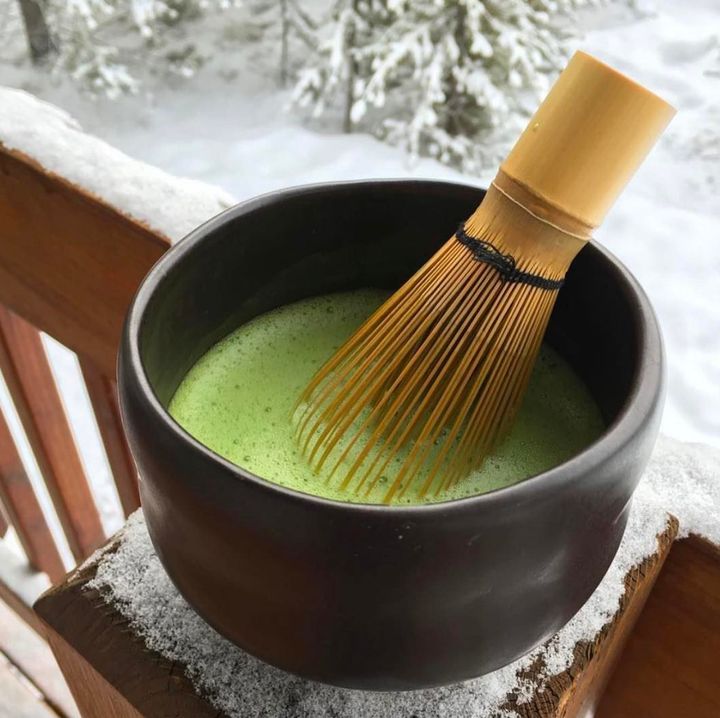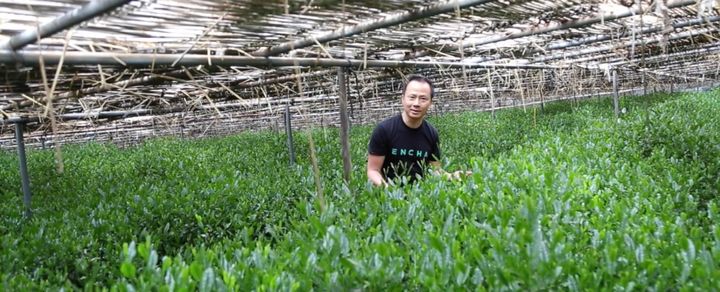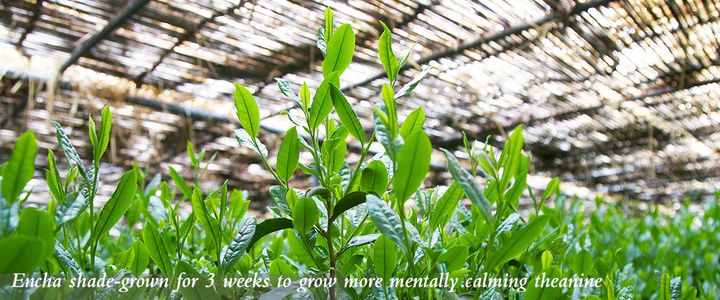Matcha is going mainstream.
If you swing into a Jamba Juice you’ll see their Matcha Green Tea Blast® Smoothie featured on the menu, and many other smoothie chains have followed suit.
Videos on YouTube showing how to make a perfect cup of matcha, or how to incorporate matcha into desserts, routinely gain hundreds of thousands of views.
And of course there are Instagram accounts entirely dedicated to matcha (such as @matchaeologist below) that have over 100,000 followers:
Yes, there are now even matcha newsletters. You can sign up to receive the latest matcha health information as well as fun new recipes.
But this love of matcha (in Japanese, “ma” means powder and “cha” means tea) is nothing new in Asia.
My own matcha interest developed during the three years I lived in Thailand, where I indulged in a variety of matcha snacks anytime I could—which was often because they are in most supermarkets and convenience stores.
Matcha in Japan, however, both embraces and goes far beyond quick snacks. Matcha is an integral part of the Japanese culture and the Zen tradition that represents an astute attention to craft, purity, and mindfulness.
One month in Japan was all it took to turn me from a typical matcha snack junkie into a person fascinated by the entire matcha-making process, including the drinking of pure matcha tea (without all the bells and whistles and sugar). I now meditate each morning with a cup of matcha in my hands.

In seeking pure matcha tea upon returning to the U.S., however, I ran into a few hurdles.
- Not all matcha is created equal, but most are presented as “the best”;
- The cost to import quality matcha from Japan was well beyond what I could afford;
- The matcha I could afford was meant for use in desserts, not whisking up a cup of tea;
- I couldn’t find a supplier that truly valued sustainable and organic matcha production.
My quest eventually led me to Dr. Li Gong, founder of Encha.

Dr. Gong (he has a PhD from Stanford University) left his stable VP position in Silicon Valley to pursue his passion for producing and enjoying sustainable, organic matcha.
There are many brands of matcha out there, and the space is becoming increasingly competitive to meet consumer demand. Consider this 5-year growth trend of Google searches for “matcha”:

But Encha remains not only the best I’ve tasted, but the matcha brand I continue to trust the most. It was a great honor, then, when Dr. Gong agreed to sit down for an interview. Let’s dive in:
CC: First, let’s get down to basics. Matcha is far more than simply powdered green tea. Can you explain to our audience what separates matcha from the tea bags of green tea they see at the supermarket?
Dr. Gong: Think of matcha as the whole green tea leaves in the ground-up powder form and tea bags as the leaf crumbs left over from processing the tea leaves. They all come from the plant Camellia sinensis.
Tea cultivation reportedly started in China about 4,000 years ago. In the Song dynasty (960–1279) of China, Zen monks created a ritual of preparing powdered green tea in a bowl. In 1191, a Zen monk named Eisai from Japan took green tea seeds from Zhejiang, China to Uji, Japan and set off the green tea cultivation in Japan.
Matcha as the core object of tea ceremony has since become perfected and well practiced in Japan. This historical lineage of Zen tradition might be one of the reasons why matcha tea ritual has a Zen spiritual element to it.
The modern cultivation of matcha makes matcha affordable to the mainstream. It bears three important characteristics:
1. It’s made from the strongest-growing plants. Our farmer picks the strongest-growing green tea plants each spring for the purpose of producing matcha powder.
Why strongest? Because green tea plants for matcha need to go through about three weeks of shaded growth. In shading, the plants get less sun and need more strength to photosynthesize and grow to their fullest before harvest.
2. Shading. I don’t know who invented the shading practice, but its effect is magical and all natural. Our farmer puts a layer of shade above the plants about three weeks before the harvest. Shading occurs in mid-to-late April in the Uji region.
Shading blocks out about 70-90% of the sun. With much less sunlight, the green tea plants grow much slower and much harder. Guess what? That makes the green tea plants grow more chlorophyll (see the analysis in this study published in the Journal of Agricultural and Food Chemistry).
That’s also why matcha is so much greener than regular green tea leaves.
The same study also documented that the plants grow more L-theanine (Theanine) during shading. A few studies I reviewed have shown some evidence that theanine helps mental calmness and focus.

Additionally, matcha powder also has more caffeine than the infusion from brewed green tea leaves or tea bags. So it is matcha’s special combination of theanine + caffeine that makes it more effective in making us feel alert and calm at the same time. Coffee beans have more caffeine than matcha and are without theanine—which is partly why many people feel jittery and experience a caffeine crash.
3. Removal of stems for a soft taste. Another unique technique in making matcha is to remove the stems of the leaves before grinding. Traditionally, workers painstakingly removed the stems by hand. Nowadays, it is much easier and this helps to make pure organic matcha affordable.
In our farm, the fresh leaves are steamed dry on the day of harvest to prevent oxidation. Then, leaves are cut into smaller pieces and blown by air onto a two-deck conveyor belt. Lighter pure leaves are blown onto the upper deck. The heavier stems settle to the lower deck. Afterwards, we manually pick out any remaining stems from the pure leaves.
Finally, we grind the pure leaves into super-fine matcha powder. At Encha, we grind about once a quarter and keep the rest of the leaves below zero Celsius in storage so we get to enjoy matcha all year round.
Whereas matcha gets the greatest care in farming and processing, tea bag tea gets the least care. When tea workers process whole leaves, there are leaf crumbs left. These tea leaf crumbs are typically used for tea bags. That’s the main reason why tea bags are so cheap.
Antioxidants in tea leaf crumbs have oxidated to quite an extent. And without the special shading process that matcha goes through, the tea bags don’t contain the extra theanine, caffeine, or chlorophyll.
CC: Your passion for matcha is clear, but take us back to those final months as a VP in Silicon Valley. You had a career that many people dream about. What factors ultimately pushed you to create your own venture, especially one in the increasingly competitive matcha space?
Dr. Gong: I graduated from Stanford University with my Ph.D. in Communication in 2001. I have always been interested in human behavior and social psychology. For survival in Silicon Valley, I focused on studying human-computer interaction.

Thanks to my interdisciplinary and creative-thinking training from Stanford, I survived quite well in a big software company for ten years. I saved some money and felt restless in wanting to move on to pursue my passion for a healthy lifestyle, and in wanting to deepen my connection with nature and human behavior.
When teas started to pop up more visibly in the U.S. market, I felt a calling to go back to my roots of green tea. I took a quest to find organic green tea farms in China and Japan.
When I tasted such delicate and beautifully green organic matcha in a farm in the Uji region of Kyoto, and felt all the main benefits of calm energy, smoother skin, faster metabolism, and stronger immunity after drinking it daily for 2-3 months, I felt so excited. I supported early customers to do self-observation.
Many of them felt the same benefits and even more benefits such as reduced inflammation and joint pain. These are all subjective reports, but they were compelling enough to convince me to quit my comfy VP job.
CC: Tell us about Encha as a company. What was your journey to founding it and what challenges did you have to overcome along the way? How do you see Encha positioned in the overall matcha market?
Dr. Gong: The main challenge is the organic matcha green tea farm discovery journey. I took the challenge before I founded Encha. With my research training, I always do enough research before I embark on a serious journey.
Founding a new company in e-commerce is quite easy. There are well-built software platforms and applications that can help you get started.
For whatever I do, I like to do it the best. From the beginning, I wanted to make Encha the best organic matcha directly from the farm to cup. I work closely with our farmer for each harvest. I create grades not from my perspective, but from a human behavior point of view to encourage healthy ways of enjoying matcha.
Besides a classic ceremonial grade using our premium 1st-harvest matcha with the best color and taste, I also created a latte grade using our 1st harvest leaves. Matcha from 2nd or later harvest (summer or autumn) tastes bitter, so I chose our standard 1st harvest as the latte grade. Sweetener is totally optional.
Personally I enjoy a bowl of ceremonial Encha whisked with hot water. But I also appreciate a healthy and foamy cup of Encha latte with almond or other non-dairy milk.
In summary, I nurture Encha as organic matcha directly from the farm and as a brand that supports each person’s healthy journey of enjoying organic matcha.
CC: As the rise of craft coffee is for some (it was for me for a few years), enjoying matcha is also part of a movement—one that appreciates slowing down, engages in meditative or other contemplative practices, and cares deeply for our planet. Can you speak a bit to what matcha has come to mean for you, beyond the product and the cup of tea?
Dr. Gong: Connecting with nature and connecting with people. I feel very fortunate to work with our farmer directly.
Organically growing matcha is not as easy as conventional farming which uses synthetic fertilizer to influence the quality and pesticide to defend the quantity. I hope the entire world can go organic one day.
With Encha, I get to connect with people every day—people who have been drinking matcha for a long time and many people who are new to matcha. They range from young moms to college students and to retirees.
CC: On a different note, I have to be honest here. Encha has set the bar for me in terms of customer service. Each shipment feels personalized and like sincere care went into it. While many companies talk a good customer service game, they fail to deliver. Why and how has customer service grown into an integral part of how Encha does business?
Dr. Gong: A key reason is my social science training at Stanford. One passion that drove me to found Encha is to support people in their quest to live healthier lives.
I always train my new employees to never push people to buy. Our job is simply to support each person’s need for healthier beverages and for a tasty cup of matcha.
Customers who proactively reach out to us tend to get personalized service because we get to learn what they need. Customers who never reach out to us might not. We do not have a magical way to automatically provide a personalized service—so feel free to reach out to us.
CC: Lastly, for those coffee drinkers on the matcha fence: How and why should they give matcha a try?
Dr. Gong: I already spoke a lot about the benefits of matcha, but I'll also add that for many coffee drinkers, coffee is a habit and dependency. And for any habit change, it is more fun and easier to grab a buddy. I have created a 5-day self-study guide for drinking matcha without coffee. I’d be happy to guide them through the process.
CC: Thanks so much for your time, Dr. Gong. I’m deeply grateful.
Dr. Gong: It is my honor to be interviewed by you and share my humble opinion. I wish every human could get a chance to whisk a bowl of matcha and offer it to another person. Our world might become more peaceful.
***
To learn more about Encha, visit Encha.com.
Cameron Conaway is the Director of Content at Reflektion
